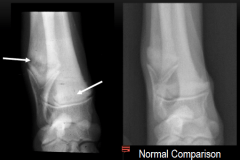One of my favorite TV shows growing up was Growing Pains. Watching the exploits of Mike, Carol, and Ben Seaver as the traveled the road of adolescence was uniquely entertaining as a pre-teen. What isn’t entertaining is watching a dog experience the tremendous growing pains caused by a disease called hypertrophic osteodystrophy or HOD. This week I share some information about this painful condition to raise awareness, and I hope you find it helpful. Happy reading!
HOD – What is it?
To best understand HOD, one needs to have a basic understanding of bone anatomy. The long bones, particularly the humerus, radius, ulna, fibula, tibia, have distinct anatomical regions. The shaft of the bone is called the diaphysis. The metaphysis is the region where the bone begins to flare. The growth plate is called the physis, and the of bone is called the epiphysis. All four regions are present in pediatric patients while only the metaphysis and diaphysis persist in adults.

In patients with HOD, blood vessels near the physis dilate and bleed into the bone. Subsequently, the bone in this region dies. This dead bone is ultimately resorbed, and microfractures develop due to the weakened state of the bone. The body eventually lays down new bone to restore normalcy. If the growth plate has been damaged, the bone can develop a bowed appearance.
To date, veterinarians don’t definitively understand the cause of HOD in dogs. Several potential factors have been investigated, including bacterial and fungal infections, viruses, excessive calcium, vaccinations, and vitamin C deficiency. The latter has received quite a bit of attention because of the similarities in both clinical signs and radiographic (x-ray) changes with infantile scurvy in humans. Dogs are actually able to synthesize their own vitamin C, so some have postulated affected dogs have a transient derangement of vitamin C metabolism, including synthesis, storage, and/or utilization.
HOD – What does it look like
Clinical signs typically develop between three and four months of age. Large and giant breed dogs are most commonly affected, and this condition is more common in certain breeds, including:
- Great Danes
- Chesapeake Bay retrievers
- Boxers
- Weimeraners
- German shepherds
- Irish setters
Some patients minimally limp while others develop non-weight bearing lameness. Severely affected animals are depressed, stop eating, lose weight, develop fevers, and develop warm, painful swelling in the region of the metaphyses of their long bones. The radius, ulna, and tibia are the most commonly affected bones. Pets can be so painful they will bite if one attempts to touch or move them.
HOD – How is it diagnosed?
Diagnosing hypertrophic osteodystrophy is relatively straightforward, based on compatible history, clinical signs, and radiographic (x-ray) appearance of affected lone bones. The characteristic radiographic appearance is transparent line (called a linear radiolucency) parallel to the physis. This line is the result of bone destruction adjacent to the growth plate.

HOD – How is it treated?
To date, there is no definite treatment for patients living with HOD. Patients undoubtedly need pain medications. Indeed, veterinarians should employ multimodal analgesia, attacking pain via different mechanisms to promote patient comfort. Patients who are unwilling to eat and drink benefit from intravenous fluid therapy and nutritional support via a temporary supplemental feeding tube. Dogs who sustain growth plate damage may require corrective surgery. Patients who remain recumbent and/or don’t receive adequate nutritional support can develop other comorbid conditions, including tissue/organ mineralization, pneumonia and bronchitis. These patients may benefit from antibiotic therapy.
Supplementation with vitamin C is not recommended. As many patients treated with this vitamin don’t respond as those that do. Some evidence suggests vitamin C supplementation could actually create more problems because treatment can cause blood calcium levels to increase, thus diminishing bone resorption.
Hypertrophic osteodystrophy is typically a self-limiting disease, and prognosis is typically good without complications. Unfortunately, some patients don’t respond to appropriate therapies. Euthanasia is recommended for these pets due to unrelenting pain.
The take-away message about HOD in dogs…
Hypertrophic osteodystrophy of HOD is generally a self-limiting disease affecting growing large and giant breed dogs. Diagnosis is based on compatible history, clinical signs, and radiographic (x-ray) changes. Treatment is largely supportive, and uncomplicated cases resolve within a few weeks. Euthanasia is the most compassionate choice for patients who don’t respond to appropriate interventions.
Wishing you wet-nosed kisses,
CriticalCareDVM





